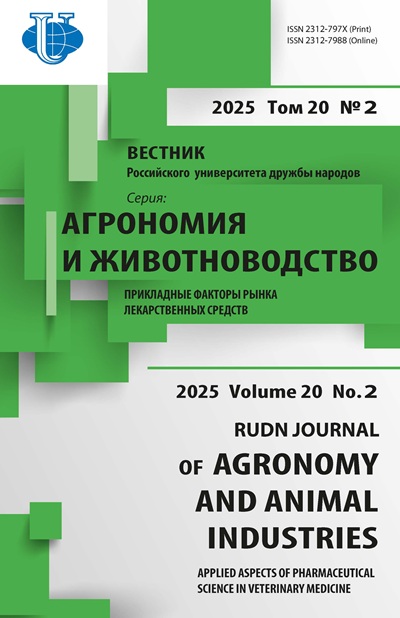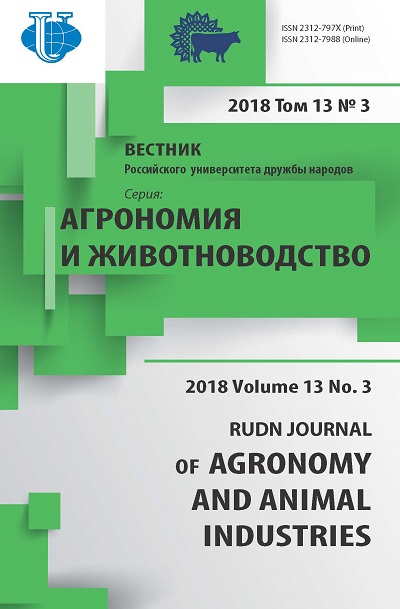CROP ROTATIONS ENSURING THE GREATEST YIELDS UNDER DRY CONDITIONS OF THE LOWER VOLGA REGION WATER-SAVING IRRIGATION REGIMES FOR VEGETABLE CROP PRODUCTION UNDER CONDITIONS OF VOLGA-DON INTERFLUVE
- Authors: Zelenev A.V.1, Pleskachev Y.N.1, Seminchenko E.V.2
-
Affiliations:
- Volgograd State Agricultural University
- Nizhnevolzhsk Research Institute of Agriculture
- Issue: Vol 13, No 3 (2018)
- Pages: 216-223
- Section: Agricultural technologies and land reclamation
- URL: https://agrojournal.rudn.ru/agronomy/article/view/19320
- DOI: https://doi.org/10.22363/2312-797X-2018-13-3-216-223
- ID: 19320
Cite item
Full Text
Abstract
About the authors
Alexander Vasilievich Zelenev
Volgograd State Agricultural University
Author for correspondence.
Email: zelenev.a@bk.ru
Doctor of Agricultural Science, Associate Professor of Volgograd State Agricultural University Universitetskiy pr., 26, Volgograd, 400002, Russian Federation
Yuriy Nikolayevich Pleskachev
Volgograd State Agricultural University
Email: pleskachiov@yandex.ru
Doctor of Agricultural Science, Professor, Head of Agriculture and Agrochemistry Department of Volgograd State Agricultural University Universitetskiy pr., 26, Volgograd, 400002, Russian Federation
Elena Valerievna Seminchenko
Nizhnevolzhsk Research Institute of Agriculture
Email: eseminchenko@mail.ru
junior research assistant of Nizhny-Volzhsky Institute of Biology and Chemistry Centralnaya st., 12, Gorodishchensky district, Volgograd, 403013, Russian Federation
References
- Belenkov AI, Gorbunova IF. Soil fertility: modern concept of justification and solution of the problem. Zernovoe khozyaistvo. 2006;(3):25. (In Russ).
- Loshakov VG. Effectiveness of separate and combined use of crop rotation and fertilizers. Achievements of Science and Technology of AIC. 2016;30(1):9-13. (In Russ).
- Mudrykh NM, Samofalova IA. Use of plant residues in soils of Non-chernozem zone of Russia (review). Perm Agrarian Journal. 2017;17(1):88-97. (In Russ).
- Perekrestov NV. Soil and climatic resources of the Volga-Don interfluve. Vestnik Prikaspiya. 2013;(2):40-47. (In Russ).
- Zelenev AV, Seminchenko EV. Efficiency of biologization in field crop rotations of dry steppe zone on light-chestnut soils of Lower Volga region. Sovremennoe ekologicheskoe sostoyanie prirodnoi sredy i nauchno-prakticheskie aspekty ratsional'nogo prirodopol'zovaniya: materialy II Mezhdunarodnoi nauchno-prakticheskoi Internet-konferentsii. Razdel Zemledelie, agrokhimiya i zashchita rastenii. Solenoe Zaimishche: PNIIAZ Publ.; 2017. P. 858-862. (In Russ).
- Kulikova AH. Differentiation of crop rotation by effect on soil organic matter regime. Vestnik of Ulyanovsk state agricultural academy. 2011;(2):27-33. (In Russ).
- Novikov AA, Kisarov ОP. Substantiation of role of root and stubble residues in agro-ecosystems. Scientific Journal of KubSAU. 2012;78(4):643-652. (In Russ).
- Shramko NV, Vikhoreva GV. Influence of biological function and fertilizers application methods on humus-power indicators of sod-podzolic soils of the Upper Volga region. Agrarnyi vestnik Verkhnevolzh'ya. 2016;14(2):13-19. (In Russ).
- Persikova TF, Cуganow AR. Agroekologiczhe aspektу zastosowania nawozov komlekowуch wogniwie zmianowania jeoznien + koniczyna. Folia Univ. agr. Stetin. Agr. 1998;72:261-263. (In Polish).
- Kozlova LM, Makarova TS, Popov FA, Denisova AV. Crop rotation as a biological method of preserving soil fertility and increasing productivity of arable land. Achievements of Science and Technology of AIC. 2011;(1):16-18. (In Russ).
- Postnikov PA. Productivity of crop rotations when using biologization methods. Agrarnyj vestnik Urala. 2015;136(6):20-23. (In Russ).
Supplementary files















